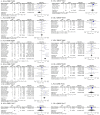Association of HLA-DR4/HLA-DRB1*04 with Vogt-Koyanagi-Harada disease: a systematic review and meta-analysis
- PMID: 25382027
- PMCID: PMC4225552
- DOI: 10.1038/srep06887
Association of HLA-DR4/HLA-DRB1*04 with Vogt-Koyanagi-Harada disease: a systematic review and meta-analysis
Abstract
Human leukocyte antigen (HLA)-DR4/HLA-DRB1*04 has been reported to be a risk factor for Vogt-Koyanagi-Harada disease (VKH) with various strength of association. Its sub-alleles were also found to be associated with VKH. However the results were inconsistent. In this study, we systematically searched the related literature, pooled the odds ratios (ORs) and 95% confidence interval (CI) of association of HLA-DR4/HLA-DRB1*04 or its sub-alleles with VKH from individual studies, and explored the potential source of heterogeneity. A total of 1853 VKH patients and 4164 controls from 21 articles were included in this meta-analysis. The pooled OR of association of HLA-DR4/HLA-DRB1*04 and VKH was 8.42 (95% CI: 5.69-12.45). There were significant heterogeneity (I(2) = 71%). Subgroup analysis indicated that ethnicity was the source of heterogeneity (all I(2) = 0, ORs ranged from 2.09-13.69 in subgroups). The sub-alleles, HLA-DRB1*0404 (OR = 2.57), 0405 (OR = 10.31) and 0410 (OR = 6.52) increased the risk of VKH; 0401 (OR = 0.21) protected VKH; while other sub-alleles were not associated with VKH. Our meta-analysis confirmed the association between VKH and HLA-DR4/DRB1*04, found the strength of association is different in different ethnic groups, and identified HLA-DRB1*0404, 0405 and 0410 as risk sub-alleles while 0401 as protective sub-allele.
Figures



References
-
- Moorthy R. S., Inomata H. & Rao N. A. Vogt-Koyanagi-Harada syndrome. Surv Ophthalmol 39, 265–292 (1995). - PubMed
-
- Yang P. et al. Clinical characteristics of Vogt-Koyanagi-Harada syndrome in Chinese patients. Ophthalmology 114, 606–614 (2007). - PubMed
-
- Sukavatcharin S., Tsai J. H. & Rao N. A. Vogt-Koyanagi-Harada disease in Hispanic patients. Int Ophthalmol 27, 143–148 (2007). - PubMed
-
- Damico F. M., Kiss S. & Young L. H. Vogt-Koyanagi-Harada disease. Semin Ophthalmol 20, 183–190 (2005). - PubMed
-
- Caillat-Zucman S. Molecular mechanisms of HLA association with autoimmune diseases. Tissue Antigens 73, 1–8 (2009). - PubMed
Publication types
MeSH terms
Substances
LinkOut - more resources
Full Text Sources
Other Literature Sources
Research Materials

